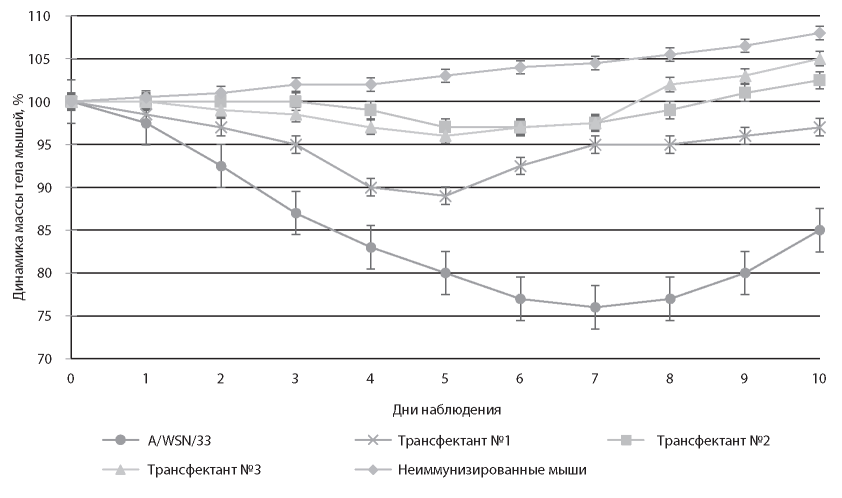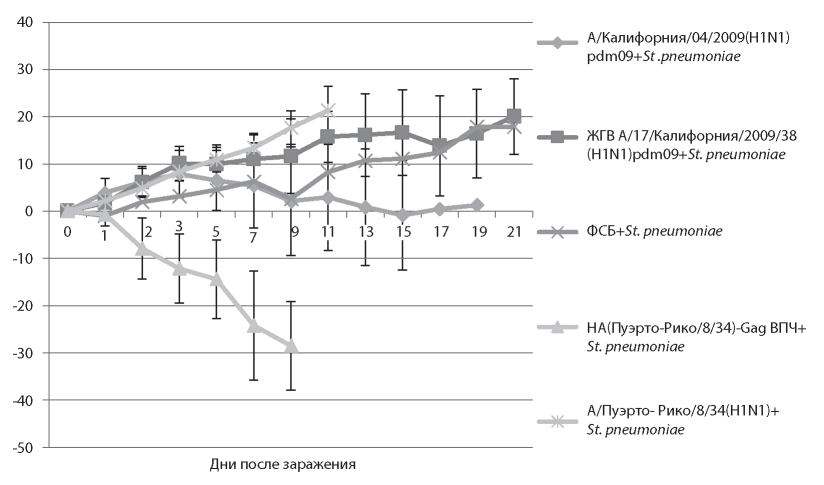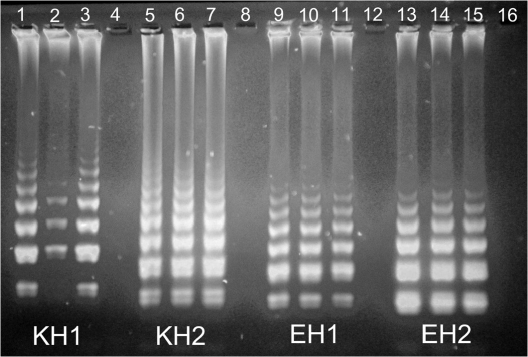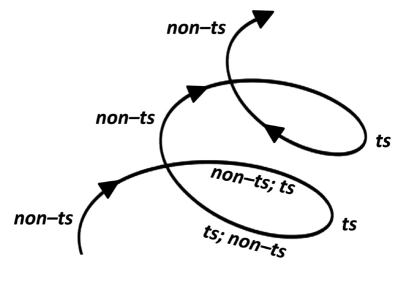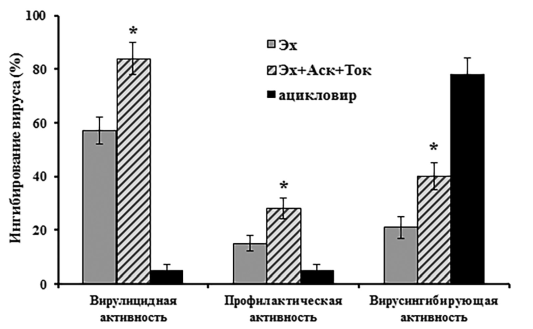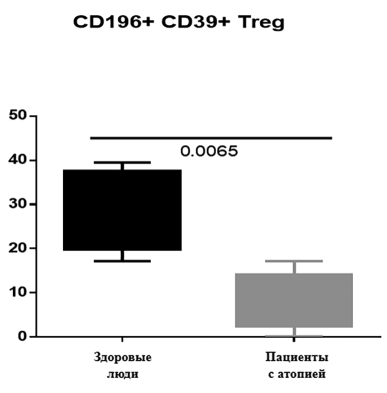Vol 96, No 6 (2019)
- Year: 2019
- Published: 16.12.2019
- Articles: 12
- URL: https://microbiol.crie.ru/jour/issue/view/26
- DOI: https://doi.org/10.36233/0372-9311-2019-6
ORIGINAL RESEARCHES
Protective effects of zinc ions towards Staphylococcus aureus bacteria exposed with antibiotics
Abstract
Objective. The work was performed with the purpose to study susceptibility of S. aureus bacteria to the action of the standard spectrum of antibiotics in presence of zinc ions used on the disks with antibiotics or on the lawn of the bacterial culture preliminarily to antibiotics treatment.
Materials and methods. Suspensions of S. aureus bacteria which contained 108 CFU/ ml were sown by the lawns into the standard Petri dishes coated with the supplemented Nutrient Agar. 30 min later the standard disks with antibiotics were passed on the surface of the lawn, and zinc sulfate was added by the drops of the volume of 5 μl on the surface of the disk. Then the dishes with bacterial cultures were incubated for 24 hrs at 37°C followed by measuring diameter of the area of culture growth inhibition. In some tests preliminarily to the disks with antibiotics passing the places of following disks application were treated with the zinc sulfate for 10 min at the room temperature.
Results and discussion. In presence of 1.0 μg/ml of zinc ions on the disk with antibiotics protective action of the metal towards the bacteria was registered at 2.9 per cent observations. In presence of one, four or eight zinc ions per one molecule of antibiotic protective action was registered at 1.4-5.7 per cent observations. Treatment with zinc ions of the surfaces of lawns followed by the disks installation resulted in 27.3-45.5 per cent observations of reducing diameter of the area of bacterial growth inhibition.
Conclusion. The treatment of the surface of the lawn of S. aureus bacteria with zinc ions cause protection of the bacteria from the following inhibitory antibiotics action.
 5-12
5-12


Inclusion of site-specific mutations in the PB1-gene of a virulent A/WSN/33 (H1N1) strain of influenza A virus changes its phenotypic characteristics
Abstract
Aim. Study of changes in the phenotypic characteristics of the virulent A/WSN/33 (H1N1) strain of influenza A virus under the influence of the inclusion of site-specific mutations in the PB1-gene of this strain.
Materials and methods. Using a two-step polymerase reaction in the PB1 gene of A/ WSN/33 (H1N1) strain were included ts mutations taken from the genome of attenuated CA donors-strains: A/Ann Arbor/6/60 (H2N2), A/Leningrad 134/17/57 (H2N2) and A/ Krasnodar/101/35/59. Ts-phenotype, att-phenotype, immunogenicity, as well as weight loss in mice infected with these mutants were studied in the obtained site-specific mutants.
Results. It was shown that the inclusion of ts mutations from the genome of CA donorsstrains of attenuation in the PB1 gene of the virulent A/WSN/33 (H1N1) strain leads to a change in the phenotypic characteristics of this strain to different degrees.
Discussion. Analysis of the genome of CA strains- donors of attenuation of influenza virus indicates the crucial importance of the presence of functional defects in the PB1– protein for the formation of the attenuation phenotype of the virus.
Conclusion. The technology of site-specific mutagenesis canbe successfully used to modify the PB1 gene of a virulent influenza A virus strain in order to construct a new generation of live influenza vaccines.
 21-29
21-29


The safety of attenuated and recombinant nasal influenza vaccines in terms of the development of secondary bacterial superinfection
Abstract
Introduction. Influenza is a severe viral disease. The most common post-influenza complication is pneumonia. Earlier, we developed an experimental mouse model of viralbacterial pneumonia induced by successive infection with influenza virus and St. aureus, in which lethal synergy between pathogens observed in epidemiological observations was detected.
Aim. To study the effect of the administration of intranasal vaccines, followed by infection with St. pneumoniae on the development and completion of the disease.
Materials and methods. The animals were immunized intranasal with a strain of attenuated cold-adapted live influenza vaccine A/17/California/2009/38 (H1N1)pdm09 (LAIV) and a recombinant vaccine based on virus-like particles HA(Puerto Rico/8/34)- Gag (VLPs). Control groups of animals were infected with virulent strains of influenza virus A/ California/04/2009 (H1N1)pdm09 or A/Puerto Rico /8/34 (H1N1). On the fifth day after intranasal immunization with the vaccine preparations and infection with pathogenic strains, animals were subjected to bacterial infection with a strain of St. pneumoniae. The presence of synergism of vaccine or viral agent with bacterial infection was assessed by survival and weight loss of animals, virus titer and density of bacteria in nasopharyngeal washes and lungs.
Results. It was shown that immunization with vaccine preparations did not lead to increased sensitivity of mice to bacterial infection. Elimination of bacteria from the lungs and nasopharynx in groups immunized with vaccine preparations corresponded to the dynamics in the group of animals immunized by PBS.
Discussion. The results obtained indicate the safety of intranasal immunization with LAIV A/17/California/2009/38 (H1N1)pdm09 and virus-like particles HA (Puerto Rico/8/34)- Gag (VLPs) in terms of enhancing secondary bacterial superinfection caused by St. pneumoniae.
Conclusion. The studied vaccines successfully blocked infections in the lower respiratory tract.
 30-39
30-39


Rapid diagnostics of genital herpes by loop-mediated isothermal amplification method with fluorescent detection
Abstract
Introduction. Due to the high clinical significance of herpesvirus diseases, the searching of fast and effective methods for their diagnosis remains relevant.
The aim of the study was to evaluate the diagnostic efficiency of the loop-mediated isothermal amplification of DNA with real-time fluorescent detection (RT-LAMP) with SYTO-82 dye on a model of herpes simplex virus (HSV) infection.
Materials and methods. A total of 44 urogenital swabs containing type 1 and type 2 HSV DNA and 43 swabs without HSV DNA, including 33 samples containing the DNA of cytomegalovirus, Epstein-Barr virus and herpesvirus type 6, were studied. For RT-LAMP, Bst 2.0 WarmStart DNA polymerase, SYTO-82 dye, LAMP primers were used.
Results. The high efficiency of HSV DNA detection in the RT-LAMP reaction with SYTO-82 dye was shown. RT-LAMP in optimal conditions allowed to reduce reaction time for 2-3 times compared to real-time PCR (to 35 minutes). Analytical sensitivity of HSV type 1 and 2 detection in RT-LAMP was 103 copies of DNA/ml. The diagnostic sensitivity and specificity of the RT-LAMP diagnosis of HSV infection were 96% and 100%, respectively.
Discussion. RT-LAMP method has a high sensitivity and specificity comparable to RTPCR, while the risk of false positive results obtaining is minimal.
Conclusion. Thus, the reaction of RT-LAMP with SYTO-82 dye allows quickly, with high sensitivity and specificity to detect HSV DNA in clinical material and can be considered as a promising point-of-care testing method.
 40-46
40-46


Microbial pathogens in urogenital infection in pregnant women
Abstract
Introduction. Chronic and latent infections are often activated during pregnancy.
Aim - to asses the pathogenetic role of microbial pathogens in urogenital tract infection (UTI) in pregnant women.
Materials and methods. 89 pregnant women underwent general clinical examination, examination of smears from urethra, vagina, cervical canal; bacteriological analysis of vaginal contents; enzyme-linked immunosorbent assay, polymerase chain reaction and determination of specific antibodies for verification of herpes simplex virus (HSV) type I and II, cytomegalovirus (CMV), Epstein-Barr (EBV) and UTI pathogens in pregnant women in blood and mucosal scrapes.
Results. Prevalence of Herpesviridae was revealed (90-100% -EBV, HSV type I and II, CMV); in 41% of cases - bacterial pathogens, in 57% of cases - Mycoplasma, Ureaplasma.
Discussion. In preterm birth and pregnancy termination mycoplasma and ureaplasma were more often revealed, and in pregnancy termination - association of HSV type I and II in comparison with urgent birth; in the last equally often - HSV type I and association of HSV type I and II; in urgent birth (infection) more often - HSV type I, than association of HSV type I and II; in preterm birth more often - HSV type I, than the association of HSV types I and II, and less often than combination of HSV type I and association of HSV types I and II in pregnancy termination; in the last, the association of HSV types I and II is more common than HSV type I. Increase of TLRs genes expression levels depends on HSV type I less than from association of HSV types I and II, less than from combination of HSV type I and association of HSV types I and II (it determines the clinical manifestations of genital herpes).
Conclusion. Microbial pathogens determine the character of pregnancy course, and HSV types I and II- are the triggers of the infectious process, prognosing its course.
 13-20
13-20


Evolution of influenza viruses based on sensitivity to temperature of replication
Abstract
Introduction. The assessment of the ability of influenza viruses to replication at temperature conditions beyond optimal values approaches us to understanding the laws of their evolutionary variability. The temperature range for the reproduction of epidemic viruses is also an important indicator for choosing a rational strategy for producing attenuated reassortants for a live influenza vaccine.
The purpose of the study is a retrospective analysis of the biological properties of influenza viruses from various pandemic and epidemic cycles based on their ability to replicate at temperatures beyond optimal values.
Materials and methods. We studied 234 strains of human influenza A and B viruses that caused epidemics in the 20th – 21st centuries. The infectious activity of viruses at different incubation temperatures was determined in developing chicken embryos. The temperature sensitivity and cold resistance of viruses replication were estimated as a difference of infectious titers at the optimum and raised or lowered incubation temperatures.
Results. Data from a retrospective study indicate that the range of sensitivity to replication temperature during the natural drift of influenza A and B pathogens is subject to regular variability that has a cyclic character.
Discussion. To assess the evolution and epidemic potential of influenza viruses, it is important not only to register a change in their antigenic properties but also to take into account the temperature sensitivity of the reproduction. Both of these properties contribute to the manifestation of the virulence of the virus. Prolonged circulation of temperature-sensitive viruses can be a prerequisite for the appearance of a radically new drift variant and even shift.
Conclusion. The analysis of the variability of the biological properties of influenza viruses approaches to the comprehension of possible ways of their evolution, that contributes to the development of rational methods for preventing the spread of viruses and the incidence caused by them.
 47-55
47-55


Activity of compounds containing echinochrome A against herpes simplex virus type 2 in vitro and in vivo
Abstract
The aim of the work was to study the activity of echinochrome A, a naphthoquinoid pigment from sea urchins, and its antioxidant composition against herpes simplex virus type 2 (HSV-2) in vitro and in vivo.
Materials and methods. Strain HSV-2 (G ATCC VR-734) was grown in Vero cells. The cytotoxic and anti-HSV-2 activity of the compounds was assessed in vitro by the cell viability and by cytopathic effect inhibition of virus using MTT test. The efficacy of compounds in mice model of vaginitis caused by HSV-2 was determined by the average lifetime, body weight and viral load changes.
Results and discussion. The antioxidant composition (echinochrome A, ascorbic acid and α-tocopherol (5:5:1)), showed a higher antiviral efficacy than echinochrome A alone. Oral administration of the antioxidant composition protected 90% of the infected mice against death and reduced vaginal viral loads. The antiviral activity of echinochrome A and the antioxidant composition is probably due to the virus-inhibiting activity of the compounds and their antioxidant properties.
Conclusion. The results obtained allow considering the tested compounds as promising agents with antiviral properties.
 56-64
56-64


Subsets of T regulatory cells in patients with IgE-mediated allergy
Abstract
Background. It is presently known that several subsets of T-regulatory (Treg) cells, both natural and inducible maintain tolerance to environmental allergens. But the relative importance of distinct phenotypically defined Treg subsets for the clinical manifestations of IgE-mediated allergy has not been elucidated yet.
The aim of the study was to investigate the phenotype and number of different Treg subpopulations from patients with IgE-mediated allergy compared with healthy non-allergic individuals.
Materials and methods. A group of 20 patients with clinically manifested IgE allergy and a group of 10 healthy no allergic controls were included in the study. Peripheral blood samples were taken after informed consent. Percentage and absolute count (AC) of the following regulatory subsets: naive (CD45RO-FoxP3lo), memory (RO+FoxP3+), effector (Treg eff, RO+FoxP3hi), induced (CD39+CD134+), Thl7/Treg (CD196+FoxP3+CD4Treg); Tr1 (IL-10+FoxP3-), were determined using standard 8-parameter flow cytometry (BD FACSCanto II).
Results and discussion. The share and AC of FoxP3+CD4 Treg was significantly decreased in sensitized patients as compared to controls (mean 0,6% vs. 3,3%, p<0.05 and 8,7 vs. 55 cells/μl p<0.001). In addition, a significantly decreased level of Tr1 cells was observed in the patients with allergy, 0,4% vs. 2,1 % in healthy controls (p<0,05) as well for subset of Thl7/Treg (mean 7,7% vs. 28,4% in healthy persons, p<0.01).
Conclusion. The significantly decreased number of FoxP3+CD4 Treg as well as periphery induced Tr1 and Thl7/Treg cells in patients with respiratory allergy lead to dysregulation and loss of peripheral immune tolerance, which is the pathophysiological basis for development of widely spread allergic diseases like allergic rhinitis and bronchial asthma.
 65-71
65-71


Detection of enterotoxigenic strains Staphylococcus aureus, producing SEC and SEI, isolated in patients with pneumonia, sepsis and burns
Abstract
Aim. To identify the frequency of occurrence of staphylococcal enterotoxins of the SEC and SEI type produced by Staphylococcus aureus strains isolated from patients with different nosology. As you know, the infection process in them proceeds with severe intoxication without vomiting and intestinal disorders.
Materials and methods. 79 strains were studied (43 were isolated in case of pneumonia, 13 - in burns, 11 - in sepsis) S. aureus in the presence of SES and SEI using enzymelinked immunosorbent assay (ELISA).
Results. It was found that 48.3% of S. aureus strains isolated from patients with pneumonia produced SEC and 72.1% - SEI. The frequency of occurrence of S. aureus strains producing SEC and SEI isolated in patients with burn infections was 23.0 and 15.4%, respectively. 36.4% of staphylococcal strains isolated in patients with sepsis produced SEC, 45.5% - SEI.
Discussion. It was found that the proportion of S. aureus cultures producing SEC enterotoxins during sepsis is significantly higher than the strains producing SEB (5.4%) and much smaller than SEA (75.6%). A high percentage of SEI-positive strains was found compared to strains that produce the classic enterotoxins SEA, SEB and SEC isolated from pneumonia. In burn infections, the proportions of strains producing SEC and SEI were 15.4 and 23.0%, respectively, which is significantly lower than SEA (92.9%).
Conclusion. The data obtained indicate the need to identify staphylococcus strains that produce both classic and newly discovered enterotoxins, which are crucial virulence factors leading to lethal sepsis, infectious endocarditis and toxic shock syndrome to eliminate them.
 72-78
72-78


REVIEWS
Bacteriophages and the immune system of the macroorganism
Abstract
Due to the emergence of antibiotic-resistant strains of bacteria in recent years, the treatment and prevention of various infections with bacteriophages have again become an important area of research. However, when using phages for this purpose, it is necessary to take into account the immune responses of a macroorganism to their introduction. The data about impact of bacterial viruses on the innate and adaptive immunity system of mammals in available literature are few and contradictory. This issue requires further detailed study, especially in the development of new therapeutic and prophylactic biological products based on bacteriophages.
 79-84
79-84


HISTORY OF SCIENCE
On the 60th anniversary of discovery and study of the far eastern scarlet-like fever
Abstract
The priority results of Russian researchers obtained over a 60-year period of studying Far Eastern scarlet-like fever (FESLF) are presented. It is proved that this previously unknown clinical-epidemical manifestation of pseudotuberculosis in medicine occurred as a result of the acquisition of special extrachromosomal genetic information (plasmid pVM 82) by the pathogen. FESLF was found to be associated with a specific clonal line of Yersinia pseudotuberculosis, extended in Russia. The results of a long-term study of DSL became the basis for revealing the fundamental issues of medical microbiology and ecology, namely: the concept of the psychrophilicity of pathogenic bacteria and the significance of this phenomenon in the epidemiology and pathogenesis of the diseases they cause, saprophytism and parasitism of pathogenic bacteria, as well as for the development of the doctrine of saprozoonoses (sapronoses) with identification of genetic and biochemical mechanisms of pathogenic bacteria adaptation to changing environmental conditions. The relevance of further research on the problem of FESLF is associated with establishment the significance of heteromorphism and persistence of Y. рseudotuberculosis in the interepidemic period.
 85-89
85-89


CHRONICLE
 90-92
90-92











